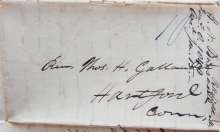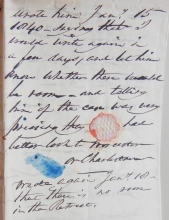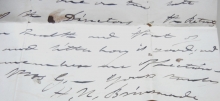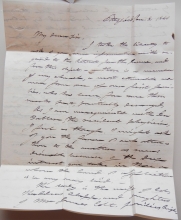Year:
Spectacular letter from Dr. Horatio Nelson Brinsmade, Pittsfield Massachusetts doctor of divinity, to his Yale Classmate Thomas Gallaudet asking him if he would treat the insane wife of one of the community’s leading citizens, Col. Thaddeus Clapp. She is also the daughter of renowned industrialist James Colt. Letter is even more significant because of the handwritten notes by Gallaudet in the margin: “wrote him Jan 1840 saying that I would write again in a few days and let him know whether there would be room and telling him if the case was very pressing they had better look to Worcester or Charlestown.” A second entry: “wrote again Jan 1840 that there is no room in the Retreat.” A pencil notation notes: 12 days centre / 4 days wing / 13 weeks in advance / bond surety.
Rev. Dr. Horatio Nelson Brinsmade From Princeton Theological Seminary Records:
Dr. Horatio N. Brinsmade was the son of Thomas C. and Elizabeth Brinsmade, and was born at New Hartford, Conn., Dec. 28, 1798. He received his preparation for College at Phillips' Academy, Andover, Mass., from John Adams, and was graduated from Yale College in September, 1822. He united with the Congregational church of his native town, New Hartford, upon profession of his faith, at seventeen years of age. Immediately after leaving Yale, he entered Princeton Seminary, where he remained nearly one year, after which he went to Hartford, Conn., and studied Theology about ‘two years under the Rev. Joel Hawes, D. D., teaching also in the Deaf and Dumb Asylum in that city from May, 1823, until Dec, 1831. He was licensed by the North Congregational Association of Hartford, in June, 1824, and was ordained by the same body as an Evangelist, June 1, 1828. He supplied the North Congregational church in Hartford a part of the years 1827 and 1828, preaching also for other churches in the vicinity during the most of his residence in Hartford. In December, 1831, he left Hartford and began to preach at Collinsville, Hartford Co., Conn. At this place a Congregational church was organized in August, 1832, which he served until Nov. 1834. At the latter date he began to preach at Pittsfield, Mass., where he was installed pastor of the First Congregational church, Feb. 11, 1835. Here he labored with great popularity and success for six and a-half years, and was released Sept. 9, 1841, having accepted a call to the Third Presbyterian church of Newark, N. J. Over this new charge he was installed Sept. 23, 1841, and here he labored with large acceptance and usefulness for twelve years. On Oct. 9, 1853, he was released by the Presbytery of Passaic. His next pastorate was over the First Congregational church at Beloit, Wis., where he was installed Feb. 10, 1854, and closed seven highly successful years of labor, Jan. 1, 1861. During nearly the whole of this time he gave gratuitous instruction in Beloit College. From Beloit he returned to Newark, N. J., where he commenced labors with a mission of the Third Presbyterian church, as a result of which the Wickliffe Presbyterian church was organized by the Presbytery of Passaic, May 14, 1865. He continued to serve this young church as stated supply until April 15, 1867, at which date he was duly installed as its pastor, from which pastoral relation he was released by Newark Presbytery April 17, 1872. He continued, however, to reside in Newark, preaching often, useful in many ways in the church and the community, honored and beloved by all around him, until his death. This event occurred Jan. 18, 1879, in the 81st year of his age. His voice was heard in exhortation and prayer a few days previously in the meetings held during the week of prayer, with no abatement of its natural force. His death was sudden, probably of heart disease, after only a few hours of illness, but all with him was light, and peace and joy in believing.
Dr. Brinsmade was thrice married. First, at Farmington, Conn., to Maria S., daughter of the Rev. Joseph Washburn, Sept. 29, 1825. Secondly, at Collinsville, Conn., to Amelia, daughter of Alexander Collins, April 29, 1833. Thirdly, at Great Barrington, Mass., Jan. 1, 1866, to Anna M., daughter of George Warner. His last wife survives him, but he had buried all his children, four in number.
Dr. Brinsmade was one of the best of men, and one of the most faithful and useful of pastors. His preaching was always with earnestness and love. He spent and was spent in the service of Christ. Having traveled extensively in Europe and the East, he had broad and intelligent views. He was faithful, affectionate, devout. The law of love was the rule of his life. He made the impress of his piety and fidelity on all who came within the reach of his influence.
Thomas H. Gallaudet Biography
Philadelphia-born T.H. Gallaudet (1787-1851) became the most prominent American educator of the deaf after studying the cause in England, Scotland and France. He founded the first public institution for the education of the hearing impaired in Hartford in 1817, serving as its president until ill health forced him to step down in 1830. His lifelong devotion to the care of the handicapped continued with his appointment as chaplain and board member of a Middletown, Ct. insane asylum where he served until his death in 1851. He also took to caring for those with mental illness and served as chaplain of both an insane asylum and a county jail.
Gallaudet attended Yale University, earning his bachelor's degree in 1805, graduating at the age of seventeen, with highest honors, and then earned a master's degree at Yale in 1808. He wanted to do many things such as study law, engage in trade, or study theology. In 1814, Gallaudet became a preacher following his graduation from Andover Theological Seminary after a two-year course of study.
However, Gallaudet's wish to become a professional minister was put aside when he met Alice Cogswell, the nine-year-old Deaf daughter of a neighbor, Dr. Mason Cogswell. He taught her words by writing them with a stick in the dirt. Then Cogswell asked Gallaudet to travel to Europe to study methods for teaching Deaf students, especially those of the Braidwood family in Edinburgh, Scotland. Gallaudet found the Braidwoods unwilling to share knowledge of their oral communication method and himself financially limited. At the same time, he was not satisfied that the oral method produced desirable results.
While still in Great Britain, he met Abbé Sicard, head of the Institution Nationale des Sourds-Muets à Paris, and two of its Deaf faculty members, Laurent Clerc and Jean Massieu. Sicard invited Gallaudet to Paris to study the school's method of teaching the Deaf using manual communication. Impressed with the manual method, Gallaudet studied teaching methodology under Sicard, learning sign language from Massieu and Clerc, who were both highly educated graduates of the school.
Having persuaded Clerc to accompany him, Gallaudet sailed back to America. The two men toured New England and successfully raised private and public funds to found a school for Deaf students in Hartford, which later became known as the American School for the Deaf. Young Alice was one of the first seven students in the United States. This is where his school began. Even some hearing students came to this school to learn. In 1821, he married one of his former students, Sophia Fowler.
Thomas Hopkins Gallaudet died at his home in Hartford on September 10, 1851, aged 63, and was buried in Hartford's Cedar Hill Cemetery. There is a residence hall named in his honor at nearby Central Connecticut State University in New Britain.
Family
His son Edward Miner Gallaudet (1837–1917) founded in 1864 the first college for the Deaf which in 1986 became Gallaudet University. The university also offers education for those in elementary, middle, and high school. The elementary school on the Gallaudet University Campus is named Kendall Demonstration Elementary School (KDES), the middle and high school is Model Secondary School for the Deaf (MSSD).
Gallaudet had another son, Thomas Gallaudet, who became an Episcopal priest and also worked for the Deaf. Gallaudet's father, Peter Wallace Gallaudet, was a personal secretary to US President George Washington, when the office of the President was located in Philadelphia.
Thomas Hopkins Gallaudet was the eldest of 13 children. His younger siblings' names were: Edgar (1789–90), Charles (1792–1830), (unnamed twins, 1793), Catherine (1793–1856), James (1796–1878), William Edgar (1797–1821), Ann Watts (1800–50), Jane (1801–35), Theodore (1805–85), Edward (1808–47) and Wallace (1811–16). William Edgar Gallaudet graduated from Yale with a B.A. in 1815.
JAMES COLT
Fall 1807 - Chancellor Livingston of New York, and James D. Colt of Pittsfield, brought the first Spanish sheep, the Merino, into Pittsfield, that sold for as high as $500 each. Watson exhibited two of these fine Spanish sheep at Park Square. This was the first time Merino sheep had been shown in New England. Merino wool could be “woven into a fabric almost as sheer and resilient as silk, yet possessing greater strength and warmth.” Its fleece was of uniform quality, which was preferred in an era when spinning was becoming a factory job. Capt. James Donaldson Colt was the son of Capt. Jas. Donaldson Colt, Pittsfield, MA, Miriam Williams was his 2nd wife. Col. THADDEUS CLAPP, the oldest woolen manufacturer in the country, has just died at Pittsfield, Mass., aged 73 years.
The Housatonic mill made its fabrics under purely democratic guidance, and in February, 1814, the following gentlemen, all federalists, were incorporated as "The Pittsfield Woolen and Cotton Factory." (Sic:) Lemuel Pomeroy, Joseph Merrick, Ebeuezer Center, Samuel D. Colt, David Campbell, Jr., Thomas B. Strong, James Buel and Arthur Schofield. Their charter was subject to the general law of 1809, regarding manufacturing companies, and they were empowered to hold real-estate to the value of thirty thousand dollars and personal property to the amount of one hundred thousand dollars. A meeting of the corporators was held April 8,1814, and, it having been determined to fix the par value of the shares at one thousand dollars each, the whole capital stock was at once subscribed, as follows: Lemuel Pomeroy, thirty shares; Arthur Scholfield, twenty; Eben. Center, thirteen; David Campbell, thirteen; Thomas Gold, five; Samuel D. Colt, thirteen; James Buel, four; James Wrigley, seven; Joseph Merrick, thirteen; William C. Jarvis, one; Thomas A. Gold, two; Isaac Scholfield, seven; Jason Clapp, one. Messrs. Center, Colt, Pomeroy, Campbell and Arthur Scholfield were chosen directors, and James Buel clerk.
The directors lost no time, but immediately purchased from Samuel D. Colt, for two thousand one hundred and twenty dollars, a tract of land consisting of five acres on the west side of the west branch of the Housatonic river, and a strip about six rods wide along the east side. Between the two there was a fine water privilege—the same now used by the lower mill of L. Pomeroy's Sons—and a dam which had recently been erected for a contemplated powder-mill.
There was no public road; but the most convenient access was by South Street, from which a private way extended to the mill, on the line upon which a road was afterwards laid by the town as described below.8
James D. Colt was engaged, at a salary of five hundred dollars per annum, commencing April 11, 1814, "to superintend the building of the factory, under the direction of the directors; he keeping an account of lost time, which was to be deducted from said five hundred dollars."
The factory built under Mr. Colt's superintendence was a substantial brick-structure eighty feet long, forty-five wide, and three stories high, besides an attic. It was lengthened, in 1871, to one hundred and twenty-five feet, and is now the lower mill of L. Pomeroy's Sons.
The factory went into operation in the spring of 1815, under as competent management as the town then afforded. Messrs. Pomeroy and Campbell had the general conduct of its affairs; Ebenezer Center, a merchant, and Samuel D. Colt, who had for some years been successfully engaged in the sheep and wool trade, were entrusted with the purchase of raw material; Arthur Scholfield had charge of the picking, carding, spinning and weaving; and Richard Lowe, an Englishman and a new-comer, was engaged to carry on the fulling, dyeing and finishing.
Mr. Thaddeus Clapp of Easthampton, became general superintendent and manager of all the departments of the mill.
Mr. Clapp was bred to the clothier's trade in his native town, and afterwards perfected himself, so far as was th'en possible in America, in all the details of the woolen-manufacture, in the factories at Middletown, Conn., and Germantown, Pa. He was the first American-born citizen of Pittsfield, who, by his native talent, thorough knowledge of his art, and general business-qualities, was competent to manage a woolen-factory. Indeed, he was the first of any nationality who was so qualified; for Scholfield, in many particulars, fell far short of that mark.
The Pittsfield Woolen and Cotton Company had thus secured an honest and capable management of its mill; but they had still the most disheartening difficulties to encounter.
The Pontoosuc Woolen Manufacturing Company, by which this mill was erected, consisted of Henry Shaw of Lanesboro, David Campbell, Thaddeus Clapp, and George W. Campbell, of Pittsfield. It was formed in 1825, but not incorporated until 1826, nor formally organized until 1827, when the following officers were chosen: Henry Shaw, president; David Campbell, Jr., general agent; Thaddeus Clapp, superintendent; George W. Campbell, clerk and treasurer.
Of Messrs. Shaw and Clapp sufficient sketches have been given. David Campbell, Jr., was born in Pittsfield in 1782, being the son of Capt. David Campbell, whose business-talents he fully inherited. Engaged in most of the commercial and manufacturing enterprises of the town during his active life, he always held a prominent place on their boards of control, as well as in those of the Agricultural Society. The confidence of his associates in his knowledge, sound judgment and integrity was unbounded, and his contemporaries paint him as shrewd, reticent, a close scrutinizer of men and things, strict in his dealings, but with a warm heart and kindly manner for those who dealt frankly and fairly with him. Previous to his connection with the Pontoosuc mill he was engaged at one time in mercantile business with James Buel. He had also been successful in distilling the oil of peppermint, a drug then in great demand for exportation. He contracted for entire fields of that herb in Lanesboro and Pittsfield; but he foresaw the glut in the market and withdrew from the speculation in season to escape loss. At another time he was engaged in the manufacture of linseed oil at Luce's mill in Pittsfield, and at a mill in Hinsdale. He died June 30, 1835.
In May, 1862, Col. Thaddeus Clapp transferred a portion of his stock to his son, Thaddeus, Jr., who was made assistant-superintendent, and in 1865, became general agent and superintendent. In 1865, Colonel Clapp died, leaving his share in the Pontoosuc property to his widow and children. In 1864, J. Dwight Francis, son of Mr. Ahniron D. Francis, having purchased a portion of David Campbell's stock, was chosen clerk and treasurer; and in 1865, assistant-superintendent.
The goods manufactured at the Pontoosuc mill, in the forty-eight years since it went into operation, have often been varied to suit the changeful moods of the market; but, since 1834, not so frequently as to forego the advantages of devotion to a single product. Indeed, many of the fabrics are of a class in regard to which the market is most fickle; and it has been the pride of the company to meet its phases promptly and profitably, without depreciating the quality of its goods.
George Campbell was born in 1811. He represented the town in the legislature 1857, and was selectman for several years. "Thaddeus Clapp, the younger, was born in 1821, being the eldest son of Colonel Thaddeus and his wife Elizabeth, who was the daughter of James I). Colt, the second of that name in Pittsfield. Familiar with woolen-mills from his infancy, he earl; acquired an accurate knowledge of all the details of the manufacture, which, together with an unusually correct taste and judgment in styles, and an intimate acquaintance with markets, gave him great success in his position.
It commenced, in 1827, upon plain broadcloths and cassimeres, making, as has been said, the mistake of attempting to supply every color, from black to crimson, and all grades of quality. This course continued until 1834, when it began the manufacture of drab carriage-cloth, for which it soon obtained a demand that occupied it exclusively, except at occasional brief intervals when black and blue broadcloths were made. This continued until 1860, when, the fashionable rage for the balmoral style of ladies' skirts commencing, the company made them a specialty; and, not only devoted all the machinery in their mill to this product, but filled several neighboring buildings with hand-looms for the same purpose. Mr. Thaddeus Clapp, having collected in Canada some recently-imported patterns, among which were the plaids of several Highland clans, was able to introduce new designs, distinguished for good taste and brilliant colors. And during the patriotic fervor of the earlier years of the civil war, a few styles in red, white and blue, added to the reputation of the company for adapting its work to the market.




